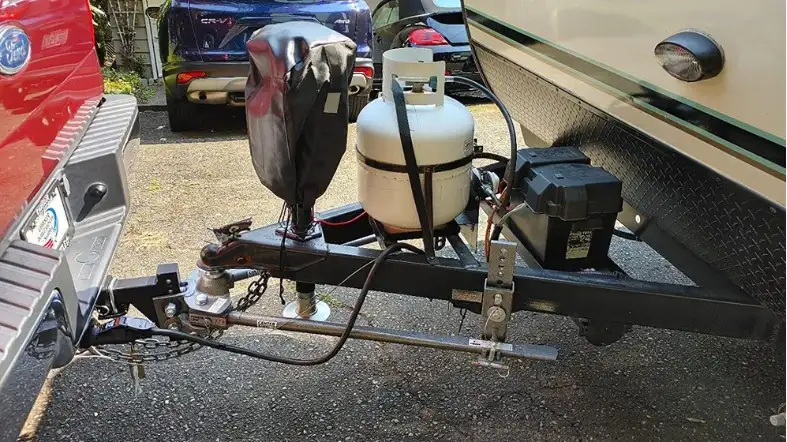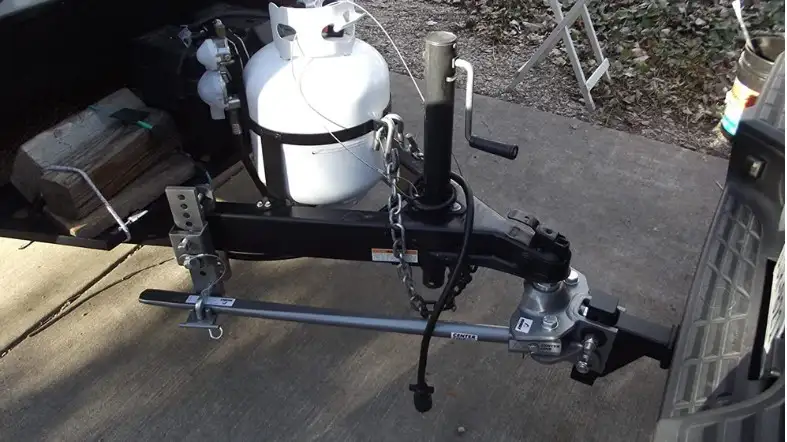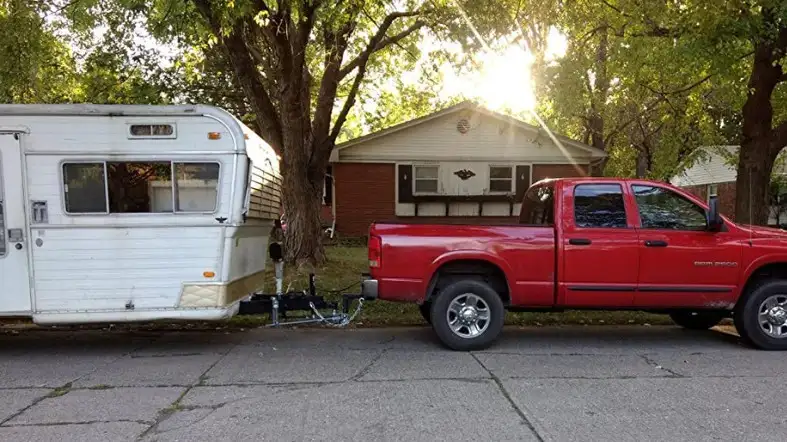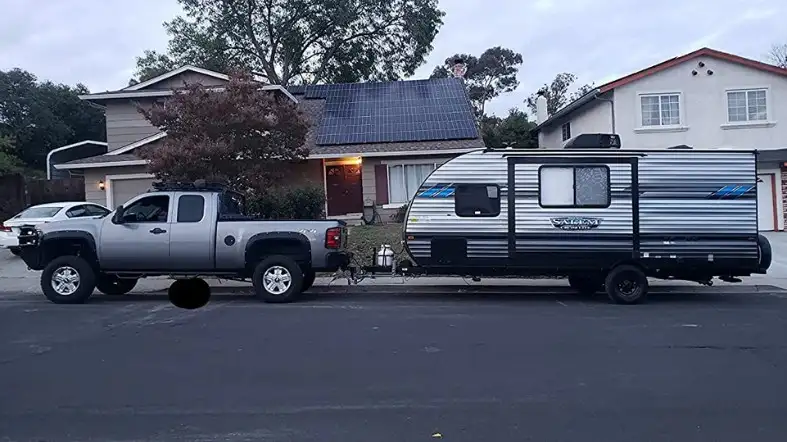Installing a weight distribution hitch with a sway bar can be a bit tricky, but with the right tools, it can be done in a relatively short amount of time.
This type of hitch is designed to distribute the weight of the trailer more evenly across the tow vehicle and the trailer, which helps to improve stability and reduce sway.
In this guide, we will walk you through the steps of installing a weight distribution hitch with a sway bar and tips for making the process as smooth and easy as possible.
How to install a weight distribution hitch with a sway bar?
Installing a weight distribution hitch with a sway bar is a crucial step in ensuring the safe and stable towing of your trailer.
The process can seem daunting at first, but with the right tools and instructions, it can be done easily and efficiently.
Before beginning the installation, make sure to gather all necessary tools and equipment, such as a weight distribution hitch, sway bar, drill, and wrenches.
To get started,

Choosing the Right Weight Distribution Hitch
The first step in installing a weight distribution hitch is to choose the right hitch for your vehicle.
There are a variety of factors to consider, such as the weight of your trailer, the type of trailer you have, and the size of your vehicle.
You will also need to decide if you want a hitch with a sway bar or without a sway bar.
Preparing Your Vehicle
Once you have chosen the right hitch for your vehicle, you will need to prepare your vehicle for installation.
This includes ensuring that your vehicle has the proper tow rating and attaching the trailer tongue to the hitch receiver.
You will also need to raise the front of your vehicle so that you can easily attach the hitch.
Attaching the Weight Distribution Hitch
After you have prepared your vehicle, you can begin attaching the weight distribution hitch.
This involves connecting the spring bars to the brackets on the hitch, as well as attaching the chains to the brackets on the trailer tongue.
Once everything is properly connected, you can lower your vehicle and tighten all of the bolts.
Adjusting the Sway Control
If your weight distribution hitch has a sway control, you will need to adjust it before hitting the road.
The amount of adjustment will depend on factors such as the weight of your trailer and the type of terrain you will be driving on.
You can typically find instructions on how to adjust your sway control in your owner’s manual.
Testing Your Weight Distribution Hitch
After you have installed and adjusted your weight distribution hitch, it is important to test it before hitting the road.
This involves checking all of the connections to make sure they are tight and checking that the trailer is level when hitched to your vehicle.
You should also test how well your vehicle steers when hitched to a trailer
What are the benefits for your towing needs?
A weight distribution hitch with a sway bar is a type of trailer hitch that helps to distribute the weight of the trailer evenly across the axle of the tow vehicle.
- The main benefit of using a weight distribution hitch with a sway bar is that it helps to prevent the trailer from swaying back and forth, which can be dangerous.
- Another benefit of using a weight distribution hitch with a sway bar is that it helps to distribute the weight of the trailer more evenly, which can help to improve fuel economy.
- Additionally, weight distribution hitches with sway bars can help to improve the handling of the tow vehicle, as they help to keep the trailer in line with the tow vehicle.
- Weight distribution hitches with sway bars are also typically easier to hook up than other types of hitches, as they do not require any special tools or equipment.
- Finally, weight distribution hitches with sway bars typically have a higher weight capacity than other types of hitches, which means they can tow heavier trailers.
How Do You Determine A Weight Distribution Hitch With A Sway Bar?

There are a few things to consider when determining if you need a weight distribution hitch with a sway bar for your vehicle and trailer combination.
Decide on the tongue weight of your trailer.
The first step in choosing a weight distribution hitch with a sway bar is to determine the tongue weight of your trailer.
Tongue weight is the downward force exerted by the trailer on the hitch ball. It should be 10-15% of the total weight of the trailer.
Choose a hitch with a capacity
Once you know the tongue weight of your trailer, you can choose a hitch with a capacity that exceeds that amount.
This will ensure that the hitch can handle the weight of your trailer without issue.
Select a hitch with a built-in sway bar.
When choosing a weight distribution hitch, be sure to select one that has a built-in sway bar.
A sway bar helps to prevent the trailer from swinging from side to side, which can be dangerous when driving.
Consider your vehicle’s towing capacity.
When selecting a weight distribution hitch, you will also need to consider your vehicle’s towing capacity.
The towing capacity is the maximum amount of weight that your vehicle can safely tow.
Be sure to choose a hitch that does not exceed your vehicle’s towing capacity.
Choose a Hitch That Is Easy to Install and Use
Finally, be sure to choose a hitch that is easy to install and use.
There are many different types of hitches on the market, so be sure to select one that will be easy for you to install and use.
How Do You Go About Installing A Weight Distribution Hitch With A Sway Bar?

To install a weight distribution hitch with a sway bar, you will need to start by gathering all of the necessary tools and supplies.
This may include:
Choosing the Right Weight Distribution Hitch
The first step in installing a weight distribution hitch is to choose the right hitch for your vehicle.
There are a variety of factors to consider, such as the weight of your trailer, the type of trailer you have, and the size of your vehicle.
You will also need to decide if you want a hitch with a sway bar or without a sway bar.
Preparing Your Vehicle
Once you have chosen the right hitch for your vehicle, you will need to prepare your vehicle for installation.
This includes ensuring that your vehicle has the proper tow rating and attaching the trailer tongue to the hitch receiver.
You will also need to raise the front of your vehicle so that you can easily attach the hitch.
Attaching the Weight Distribution Hitch
After you have prepared your vehicle, you can begin attaching the weight distribution hitch.
This involves connecting the spring bars to the brackets on the hitch, as well as attaching the chains to the brackets on the trailer tongue.
Once everything is properly connected, you can lower your vehicle and tighten all of the bolts.
Adjusting the Sway Control
If your weight distribution hitch has a sway control, you will need to adjust it before hitting the road.
The amount of adjustment will depend on factors such as the weight of your trailer and the type of terrain you will be driving on.
You can typically find instructions on how to adjust your sway control in your owner’s manual.
Testing Your Weight Distribution Hitch
After you have installed and adjusted your weight distribution hitch, it is important to test it before hitting the road.
This involves checking all of the connections to make sure they are tight and checking that the trailer is level when hitched to your vehicle.
You should also test how well your vehicle steers when hitched to a trailer
What Are Some Tips For Using A Weight Distribution Hitch With A Sway Bar?

There are a few key tips that can help you successfully use a weight distribution hitch with a sway bar. Some of these include:
Read the Instructions
Before you do anything, it is important that you read the instructions that came with your weight distribution hitch and sway bar.
This will give you a good understanding of how the two products work together and how to properly set them up.
Adjust the Sway Bar
One of the most important things to do when setting up your weight distribution hitch is to adjust the sway bar.
The sway bar helps to distribute the weight evenly across the trailer and prevents it from shifting from side to side.
You will want to adjust the sway bar so that it is level with the ground.
Set Up the Weight Distribution Hitch
Once you have adjusted the sway bar, you can then begin to set up the weight distribution hitch.
First, you will need to attach the brackets to the frame of your trailer.
Next, you will need to attach the chains or straps to the brackets.
Make sure that the chains or straps are tight so that they do not come loose while you are driving.
Adjust the Height of the Trailer
Another important thing to do when setting up your weight distribution hitch is to adjust the height of your trailer.
You will want to raise or lower your trailer until it is level with your tow vehicle.
This will help to distribute the weight evenly and prevent your trailer from tipping over.
Test It Out
Once you have everything set up, it is important to test it out before hitting the road.
Hook up your trailer and tow vehicle and slowly drive around a parking lot or other safe area.
Pay attention to how your trailer is tracking behind your tow vehicle and make sure that there is no excessive movement from side to side.
FAQs About installing a weight distribution hitch with a sway bar
What Are The Basic Steps For Installing A Weight Distribution Hitch With A Sway Bar?
First, identify and mark where you will mount your trailer’s hitch.
Then, attach the sway bar and spring bars to the hitch assembly using whatever appropriate hardware or connectors are available.
Depending on your weight distribution hitch and trailer, you might need to adjust or fine-tune everything once it is all installed.
What Tools And Equipment Will You Need To Complete This Process?
The tools and equipment you will need to complete this process will depend on the type of weight distribution hitch you are using.
Generally, you will need a set of ratchets and wrenches, as well as other hand tools like pliers or screwdrivers.
You may also need additional mounting hardware, such as bolts or nuts, depending on the specific configuration of your hitch and sway bar.
Are There Any Potential Challenges Or Risks That Can Arise When Installing A Weight Distribution Hitch With A Sway Bar?
There are a few potential challenges or risks that can arise when installing a weight distribution hitch with a sway bar, such as difficulty aligning the mounting points or improperly adjusting the setup once everything is in place.
Conclusion
Now that you know how to install a weight distribution hitch with a sway bar, you can get started on the project.
Remember to take your time and be patient, and if you have any questions, don’t hesitate to reach out to us. We’re here to help!
